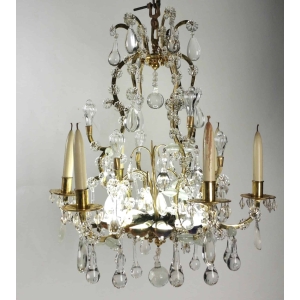Henri Vian (1860-1905) – Lustre en bronze argenté de style Louis XVI vers 1890
Un élégant et décoratif lustre de forme cage en bronze argenté, éclairant par huit bras de lumière et huit grands poignards éclairants en cristal taillé en périphérie, au centre : un beau poignard éclairant en cristal taillé et quatre petites lumières. Le lustre est composé de grandes plaquettes en cristal taillé de la Maison Baccarat et se termine par une belle boule en cristal taillé.
Beau travail français de la fin du XIXème siècle, vers 1890, signé par Henri Vian sur la bélière. La cristallerie est attribuée aux Cristalleries de Baccarat.
Dimensions : Hauteur 110 cm – diamètre 65 cm.
En très bon état de conservation.
Biographie :
Henri Vian, célèbre bronzier et fondeur, grand-père de Boris Vian, était spécialisé dans la production de bronzes d’’ameublement, vases décoratifs, pièces de cheminée ainsi que différents équipements d’’éclairage.
Auteur des grilles de la villa ARNAGA, résidence d’’Edmond Rostand à Cambo-les-Bains.
Henri Vian participa aux différentes Expositions Universelles de 1878, 1889 et 1900 et fût médaillé d’or en 1889.
C’’est au 5 de la rue de Thorigny à Paris, actuel Musée PICASSO, qu’était installé ses magasins.
Après son décès, en 1905, son épouse, puis son fils Paul (père de Boris) reprirent la Maison de décoration, jusqu’en 1944, date à laquelle la ville de Paris acheta les lieux pour y installer l’’École des Métiers d’Art, actuel siège du Musée Picasso.
Baccarat :
En 1764, le roi Louis XV accorde à Louis-Joseph de Montmorency-Laval, évêque de Metz, l’autorisation d’établir une verrerie dans le village de Baccarat en Lorraine.
En 1824, Ismaël Robinet, ouvrier verrier de Baccarat, invente une pompe à air pistonné qui facilite le soufflage du verre. L’année suivante, Baccarat développe la technique du pressé-moulé.
En 1855, Baccarat participe à la première Exposition universelle parisienne, avec notamment deux candélabres et un lustre de dimensions monumentales.
En 1860, le 29 octobre, Baccarat dépose sa marque de fabrique au tribunal de commerce de Paris : une carafe, un verre à pied et un gobelet inscrit dans un cercle. D’abord imprimée sur une étiquette en papier, l’estampille sera ensuite directement gravée sur la pièce.
Baccarat est un cristal d’une excellente qualité, il ne contient pas moins de 31,7% de plomb, sans aucun default, un haut niveau d’exigence, voici ce qui caractérise la manufacture. La Cristallerie de Baccarat traverse les générations tout en restant un symbole de l’art de vivre à la Française.
Henri Vian (1860-1905) – Louis XVI style silvered bronze chandelier circa 1890
An elegant and decorative silver-plated bronze chandelier of cage form, illuminated by eight arms of light and eight large illuminating daggers in cut crystal on the periphery, in the middle: a beautiful illuminating dagger in cut crystal and four small lights. The chandelier is composed of large baccarat-cut crystal plates and ends with a beautifully cut crystal ball.
A fine French work from the late 19th century, circa 1890, signed by Henri Vian on the bélière. The crystal work is attributed to the Cristalleries de Baccarat.
Sizes: Height 43.30 Inches. – Diameter 25.59 Inches.
In fine original condition.
Biography:
Henri Vian, a famous bronze maker, and foundryman, grandfather of Boris Vian, specialized in the production of furniture bronzes, decorative vases, fireplace mantels, and various lighting fixtures.
He designed the ornamental railings for the Villa ARNAGA, Edmond Rostand‘’s residence in Cambo-les-Bains.
Henri Vian took part in the various Universal Exhibitions of 1878, 1889, and 1900 and was a gold medallist in 1889.
His shops were located at 5 rue de Thorigny in Paris, now the Picasso Museum.
After he died in 1905, his wife and then his son Paul (father of Boris) took over the decorating business until 1944, when the City of Paris bought the premises and set up the École des Métiers d’Art, now the Picasso Museum.
Baccarat:
In 1764, French King Louis XV granted Louis-Joseph de Montmorency-Laval, Bishop of Metz, permission to establish a glassworks in the Lorraine village of Baccarat.
In 1824, Ismaël Robinet, a Baccarat glassmaker, invented an air-piston pump that facilitated glassblowing. The following year, Baccarat developed the press-molded technique.
In 1855, Baccarat took part in the first Paris Universal Exhibition, exhibiting two monumental candelabras and a chandelier.
In 1860, on October 29, Baccarat registered its trademark with the Paris Commercial Court: a carafe, a stemmed glass, and a beaker inscribed in a circle. Initially printed on a paper label, the stamp was later engraved directly onto the piece.
Baccarat crystal is of the highest quality, containing no less than 31.7% lead, with no defaults and the highest standards. Cristallerie de Baccarat has been passed down through the generations and remains a symbol of French art de vivre.



































